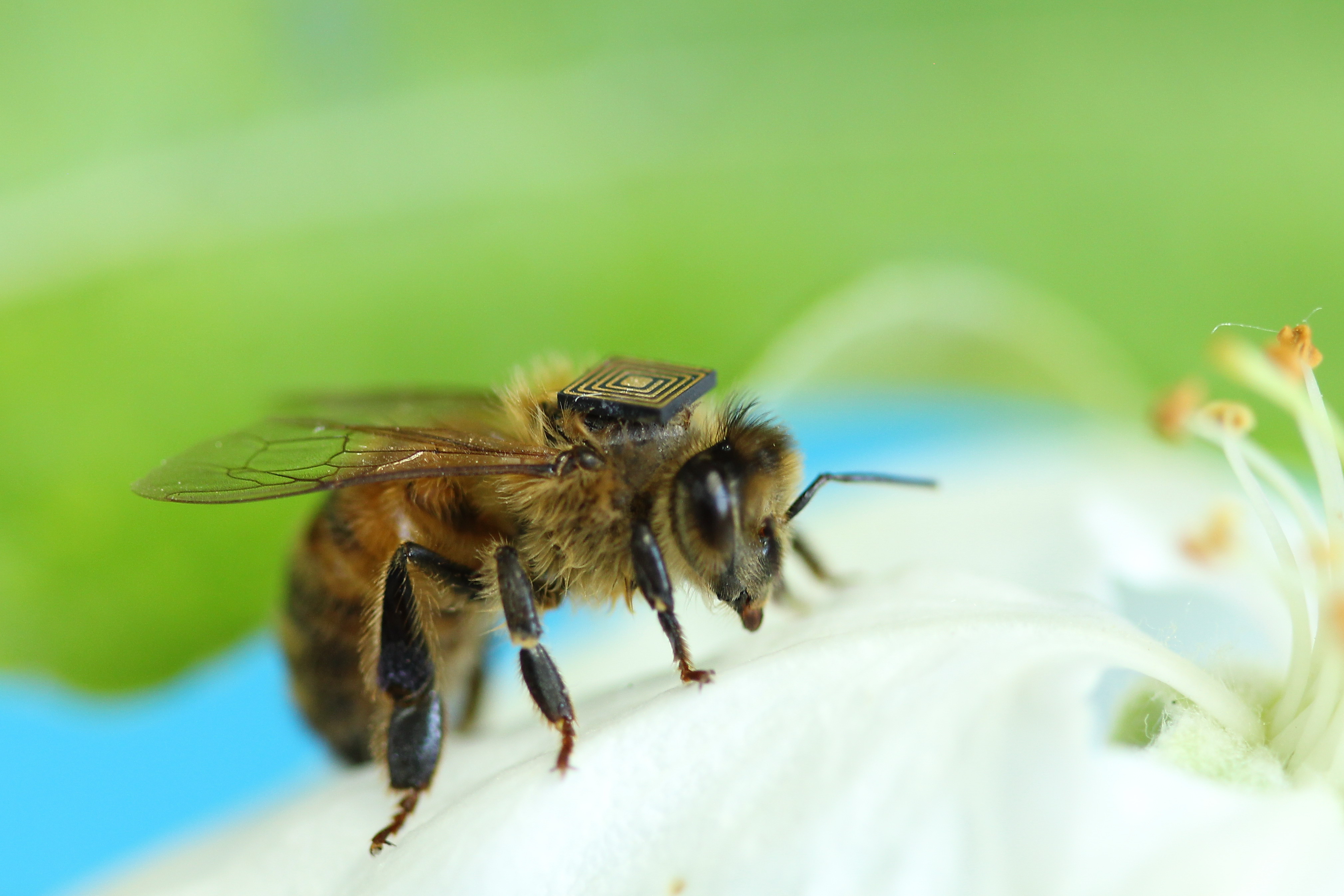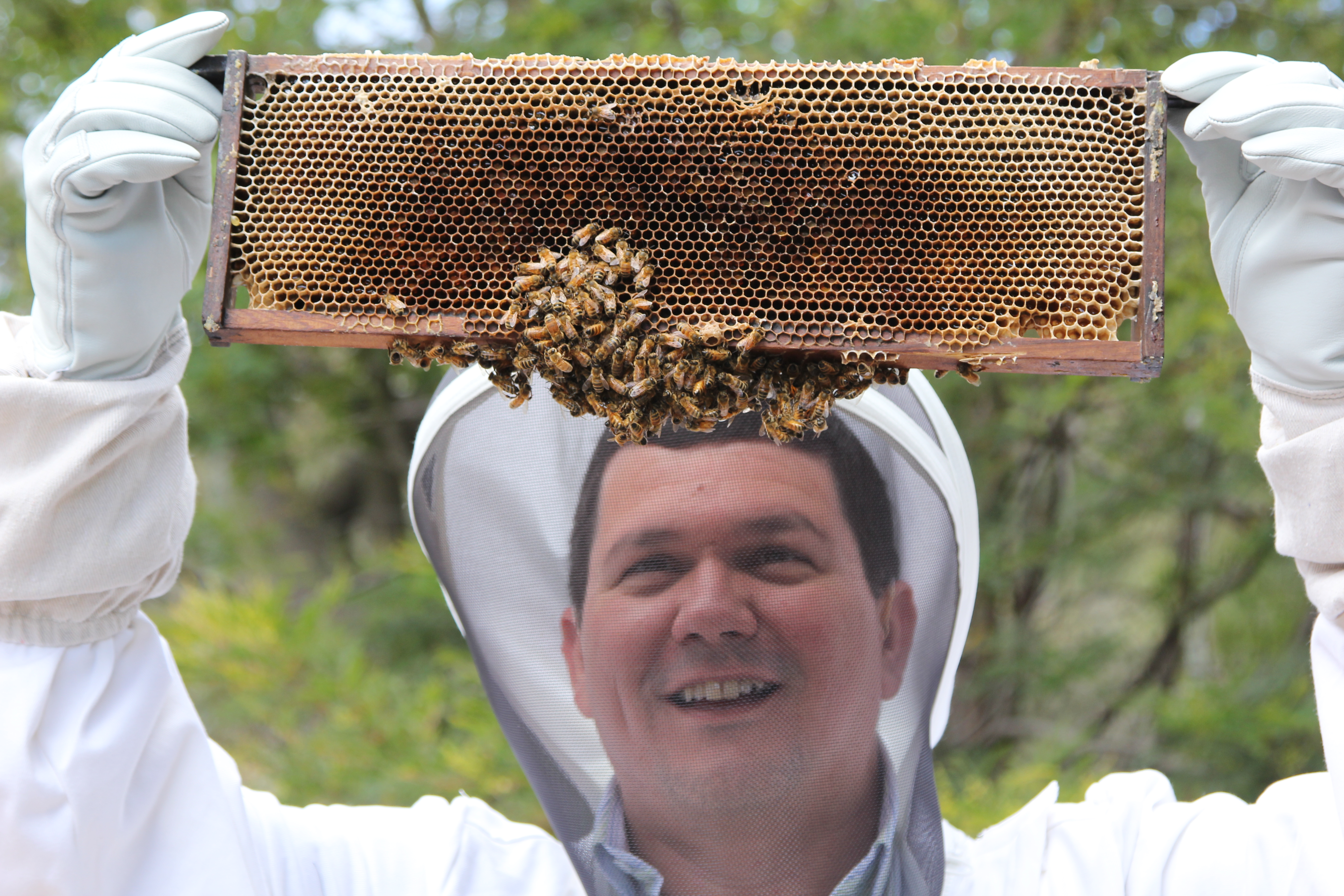
Bee with a backpack… of the sensor variety.
What if I told you that insects in the environment may be able to tell us about the world they live in? Imagine it; they could reveal changes in climate, the presence of dangerous gases or even the arrival of pests. Now you might think this a flight of fancy and tell me to buzz off, but this may not be so far from reality.
Our new research project is using tiny sensors that act like your car’s e-tag and attaching them to the backs of honey bees.
What the?
You heard right – bees with a chip on their shoulder, or on their back at least.
These tiny 2.5mm x 2.5mm chips relay data to recorders placed around hives and known food sources. We’re not talking about one or two wired up insects here, 5,000 tags are currently being attached to honey bees in Hobart and released into the natural environment.
And why would our researchers do that?
Collecting bee movement information at this scale is a world first and will allow researchers to generate a four dimensional model (three dimensions over time) of bee behaviour and the way these insects move through the landscape. This information is needed on a global scale as wild honey bee populations are dropping drastically or vanishing all together. In some instances this is because of the parasitic Varroa mite. In others it’s a case of Colony Collapse Disorder, which is believed to be caused by diseases and agricultural pesticides.
CSIRO’s Dr Paulo de Souza leads the project and talks about why it is so important to protect these often feared insects. He says:
Honey bees play an extremely important role in our daily lives. Around one third of the food we eat relies on pollination and this is a free service these insects provide. A recent CSIRO study showed that honey bees helped increase faba bean yield by up to 17 per cent. Knowing how bees interact with their environment will allow farmers, fruit growers and seed producers to manage their properties using honey bees to increase productivity.

Dr Paulo with his beloved bees.
The research is also looking at the impacts of farm pesticides on honey bees and how much these chemicals contribute to CCD. Healthy bees means healthy landscapes.
Tagging the bees is only the first stage in the project. The next requires us to make the sensors even smaller, down to the size of a grain of sand so they can be used on smaller insects like mosquitoes and fruit flies.
“We also want these smaller tags to be able to sense environmental conditions such as temperature and presence of atmospheric gases; not just track their location.”
“Further to this the sensors will be able to generate energy from the beating wings of the insects, which will give the sensors enough power to transmit information instead of just storing it until they reach a data logger,” says Dr De Souza.
In short, insects will be real-time ‘swarm sensing’ at a scale never before achieved. Insects could become the canaries of the mines or the sniffer dogs of the airports. Bring on the buzz.
Media: Emma Pyers, +61 3 5227 5123, emma.pyers (at) csiro.au


29th October 2014 at 3:08 pm
Hi! My name is Stacey and I run a blog called Bee Kind Australia beekindaus.wordpress.com
This is really great! I was wondering how the bees in Australia are currently doing compared to bees in other parts of the world?
30th October 2014 at 10:04 am
Pretty well. We don’t have varroa mite, or colony collapse disorder. As a result, we’re exporting bees to affected countries.
30th October 2014 at 3:27 pm
That’s great! I thought that was the case. I’m trying to raise awareness in Australia about the global decline and get people to take action on a small scale that will ultimately benefit our bees here.
8th October 2014 at 11:58 pm
Dear Step,
Congratulation for this wonderful results.
I am a beekeeper, and I want to make some kind of similar investigation, but inside the hive.
I would be interested in how could you enlarge the reading range till 30 cm.
Which kind of reader did you use?
Regards
Frank
18th June 2014 at 2:02 am
How small can we go with technology all that data and crusher
8th May 2014 at 6:41 pm
Hello there guys,
How’s the research going. Is the data you’re collecting helping? Hope it is all going well.
Regards Sandra Kenny
9th May 2014 at 8:20 am
Hi Sandra, thanks for getting in touch. The research is going really well with most of the sensors now deployed. Things will quieten down a bit in the coming weeks as the weather gets cooler, but that will give us time to start looking at the data. We’ll keep you posted!
Cheers,
Steph
6th May 2014 at 8:14 am
I saw the specs of the RFID tag and the Read Range is about 5-10mm. How do you increase this read range to locate your bees ? What reader and antenna do you use ? Do you use a specific software to locate the bees ?
8th May 2014 at 12:15 pm
Hi there, we designed and built our own boosting antennas to increase the range of these tags – up to 30cm. We also had to design specific software allowing information to be remotely sent to a host computer that captures the data. This is then used to produce a 3D visualisation of the bees movements.
Cheers,
Steph
30th May 2014 at 4:17 am
Thank you !
And do you know where to buy such tags ?
30th May 2014 at 12:26 pm
Hi there, the sensors we’re using for this program actually come from Japan and are made by Hitachi. It’s best to get in touch with them for more details.
Cheers,
Steph